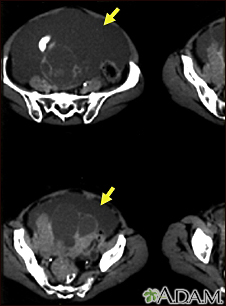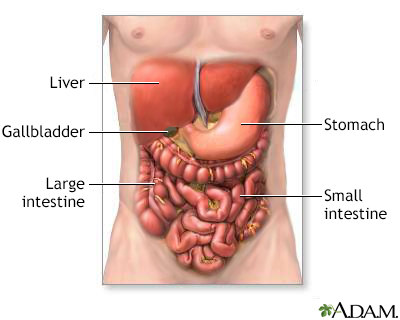Ascites
Portal hypertension - ascites; Cirrhosis - ascites; Liver failure - ascites; Alcohol use - ascites; End-stage liver disease - ascites; ESLD - ascites; Pancreatitis ascites
Ascites is the build-up of fluid in the space between the lining of the abdomen and abdominal organs.

This CT scan of the lower abdomen shows a massive amount of free abdominal fluid (ascites) in a patient with ovarian cancer.

The digestive system organs in the abdominal cavity include the liver, gallbladder, stomach, small intestine and large intestine.
Causes
Ascites often results from high pressure in certain veins of the liver (portal hypertension) and low blood levels of a protein called albumin.
Diseases that can cause severe liver damage can lead to ascites. These include:
- Chronic hepatitis C or B infection
- Alcohol overuse over many years
- Fatty liver disease (metabolic associated steatohepatitis (MASH) previously called non-alcoholic steatohepatitis or NASH)
- Cirrhosis caused by genetic diseases
People with certain cancers in the abdomen may develop ascites. These include cancer of the appendix, colon, ovaries, uterus, pancreas, bile ducts, and liver.
Other conditions that can cause ascites include:
- Clots in certain veins of the liver (portal vein thrombosis)
- Congestive heart failure
- Pancreatitis
- Thickening and scarring of the sac-like covering of the heart (pericarditis)
Kidney dialysis may also be linked to ascites.
Symptoms
Symptoms may develop slowly or suddenly depending on the cause of ascites. You may have no symptoms if there is only a small amount of fluid in the belly.
As more fluid collects, you may have abdominal pain and bloating. Large amounts of fluid can cause shortness of breath. This happens because the fluid pushes up on the diaphragm, which in turn compresses the lower lungs.
Many other symptoms of liver failure may also be present.
Exams and Tests
Your health care provider will do a physical exam to determine if the swelling is likely due to fluid buildup in your belly.
You may also have the following tests to assess your liver and kidneys:
- 24-hour urine collection
- Electrolyte levels
- Kidney function tests
- Liver function tests
- Tests to measure the risk of bleeding and protein levels in the blood
- Urinalysis
- Abdominal ultrasound
- CT or MRI scan of the abdomen
- Blood test to determine the cause of any liver failure leading to ascites.
Your provider may also use a thin needle to withdraw ascites fluid from your belly. This procedure is called an abdominal tap or paracentesis. The fluid is tested to look for the cause of ascites and to check if the fluid is infected. Sometimes a large amount of fluid is removed to make you more comfortable.
Treatment
The condition that causes ascites will be treated, if possible.
Treatments for fluid build-up may include lifestyle changes:
- Avoiding alcohol
- Lowering salt in your diet (no more than 1,500 mg/day of sodium)
- Limiting fluid intake
You may also get medicines from your doctor, including:
- "Water pills" (diuretics) to get rid of extra fluid
- Antibiotics for infections
Other things you can do to help take care of your liver disease are:
- Get vaccinated for diseases such as influenza, hepatitis A and hepatitis B, and pneumococcal infection
- Talk to your provider about all medicines you take, including herbs and supplements and over-the-counter medicines
Procedures that you may have are:
- Inserting a needle into the belly to remove large volumes of fluid (called an abdominal tap or paracentesis)
- Placing a special tube or shunt inside your liver (TIPS) to repair blood flow to the liver
People with severe liver disease may need a liver transplant.
If you have cirrhosis, avoid taking nonsteroidal anti-inflammatory medicines, such as ibuprofen (Advil, Motrin) and naproxen (Aleve, Naprosyn). Acetaminophen should be taken in reduced doses.
Possible Complications
Complications may include:
- Spontaneous bacterial peritonitis (a life-threatening infection of the ascitic fluid)
- Hepatorenal syndrome (kidney failure)
- Weight loss and protein malnutrition
- Mental confusion, change in the level of alertness, or coma (hepatic encephalopathy)
- Bleeding from the upper or lower gastrointestinal tract
- Build-up of fluid in the space between your lungs and chest cavity (pleural effusion)
- Other complications of liver cirrhosis
When to Contact a Medical Professional
If you have ascites, contact your provider right away if you have:
- Fever above 100.5°F (38.05°C), or a fever that does not go away
- Belly pain
- Blood in your stool or black, tarry stools
- Blood in your vomit
- Bruising or bleeding that occurs easily
- Build-up of fluid in your belly
- Swollen legs or ankles
- Breathing problems
- Confusion or problems staying awake
- Yellow color in your skin and the whites of your eyes (jaundice)
References
Garcia-Tsao G. Cirrhosis and its sequelae. In: Goldman L, Cooney KA, eds. Goldman-Cecil Medicine. 27th ed. Philadelphia, PA: Elsevier; 2024:chap 139.
National Institute of Diabetes and Digestive and Kidney Diseases website. Cirrhosis.
Sola E, Gines SP. Ascites and spontaneous bacterial peritonitis. In: Feldman M, Friedman LS, Brandt LJ, eds. Sleisenger and Fordtran's Gastrointestinal and Liver Disease. 11th ed. Philadelphia, PA: Elsevier; 2021:chap 93.
Version Info
Last reviewed on: 8/12/2024
Reviewed by: Jenifer K. Lehrer, MD, Gastroenterologist, Philadelphia, PA. Review provided by VeriMed Healthcare Network. Also reviewed by David C. Dugdale, MD, Medical Director, Brenda Conaway, Editorial Director, and the A.D.A.M. Editorial team.
